
As many of us reflect upon the birth of the Khalsa this Vaisakhi, throughout North America (and beyond) our communities come together in celebration. Covered here is a round-up of Vaisakhi celebrations with various media links. If your city is covered here, provide us some context/anecdotes about your experience. If your city is NOT covered here, provide us some context/anecdotes about your experience.
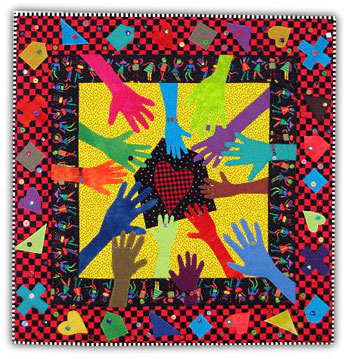 A few years back, I went to my first Charni Lagna ceremony. Charni Lagna – literally, “at the feet of the Guru” is the traditional name of the event where a Sikh formally begins reading from the Guru Granth Sahib.
A few years back, I went to my first Charni Lagna ceremony. Charni Lagna – literally, “at the feet of the Guru” is the traditional name of the event where a Sikh formally begins reading from the Guru Granth Sahib.
Like most Sikh ceremonies, it is actually quite simple. After shabad kirtan is recited, an ardaas is offered for the young (or old) Sikh who is beginning their journey with the Guru – then finally, he or she will read the hukamnama.
The ceremony I attended was for an 11-year old girl, who was very excited and worked hard to prepare for this day. After a few shabads were sung by the local jatha and the girl’s friends – one by one, members of the sangat came to say a few words of encouragement. One of her friends was around the same age and similarly went through this ceremony a year prior. She spoke about her own experience reading from the Guru Granth Sahib on a daily basis and how it has changed her life. Then one of her friends who had yet to take this step spoke of how she was inspired to do so soon. Then came her Punjabi school teacher, then her camp counselors, then other leaders of the community. I noted that neither her parents nor any of her relatives spoke – but instead, they just sat and listened to the members of the sangat, who individually shared such beautiful words of encouragement and praise for this young Kaur, who humbly sat at the feet of the Guru…It was quite powerful.
Finally, as the ardaas ended, there was a rare moment of pin-drop silence in the darbar hall. Then this brave 11 year old girl, surrounded by her proud parents and grandparents, read the hukamnama flawlessly…I was moved by the whole event.
Immediately after the hukmanama was completed, something remarkable happened…
Sikhs will be celebrating Vaisakhi world wide next week on April 14th. Sikhs in Malayasia are requesting that Vaisakhi be made a national holiday.
Tan Sri Darshan Singh, the President of Malaysia National Sikhs Movement president, said, “The Sikhs who arrived earlier in this country served in the security forces and have contributed towards the economic development of Malaysia”. Karpal Singh of DAP believes that Vaisakhi should be given consideration as a national holiday because of its considerable significance to Sikhs. However, Malaysian Sikhs have not gotten a positive response from the government.
A common saying is a community knows when its contributions are being viewed as an important part of a “host” country’s fabric of life when the entire nation gets a day off on a day that is significant to that community. In a nutshell, it means you have really “made it”.
I look forward to the day that non-Sikhs will be taking Vaisakhi off in Malaysia and America. We have “made it” in these countries in many ways although we are often treated like “resident aliens”. I wish it wouldn’t take a national holiday to break that mold, but may be it would help?
A true Sikh hero, Fauja Singh, turned 99 last Thursday.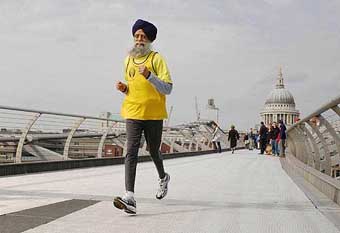
Turbaned Tornado, Fauja Singh turns 99 on Thursday. Here’s wishing this Punjabi icon who manages running marathons at an age not many reach, many happy returns of the day. Besides other gifts that he’d be receiving on his birthday on April 1, this real life ‘Forest Gump’ is all set to give himself a present — by setting yet another marathon record at the ripe age of 99. “I can only sleep, run or walk. I’ll die the day I sit down,” the young nonagenarian had told this scribe in an interview in 2005 on the streets of Ilford, Essex, UK, where he has been living along with his son Sukhjinder Singh since the 1980s. He shifted to UK after having lost his wife and younger son in quick succession in Punjab. [TOI]
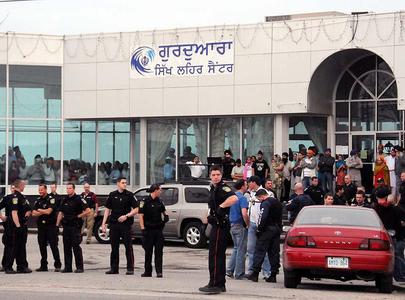 As many Sikhs throughout the world are gearing up to celebrate Vaisakhi, we continuously get disheartening news as well. In Toronto there was a shameful incident this weekend.
As many Sikhs throughout the world are gearing up to celebrate Vaisakhi, we continuously get disheartening news as well. In Toronto there was a shameful incident this weekend.
A former judge, now a prominent Brampton lawyer, is in hospital with serious stab wounds when a mob turned deadly at a Sikh temple on Friday evening.Manjit Mangat, 53, is in hospital with multiple stab wounds to his abdomen, thighs and legs and cuts on his face after he was attacked inside the Sikh Lehar Centre, a temple at Bramsteele Rd. near Steeles Ave. and Hwy. 410.[link]
The worst exhibit I saw ..and I know BOTH sides are guilty of this, was the declaration that the other side are not Sikhs. Both sides need to mature and grow up. I hope the Sikh youth can provide a better example for our elders.[link]
Last week, many in US Sikhdom celebrated the triumphs of Captain Tejdeep Singh Rattan and Dr. Kamaljeet Singh Kalsi. For why you may ask? See previous coverage.
The NY Times Printed this short brief:
Capt. Tejdeep Singh Rattan, in a turban and full beard, graduated Monday at Fort Sam Houston in San Antonio, the first Sikh in a generation allowed to complete Army basic training without sacrificing the articles of his faith. The Army made an exemption to a uniform policy that has effectively prevented Sikhs from enlisting since 1984. “I’m feeling very humbled,” said Captain Rattan, 31, a dentist. “I’m a soldier.” He had to get a waiver from the Army to be allowed to serve without sacrificing the unshorn hair mandated by his faith. An immigrant from India who arrived in New York as a teenager, Captain Rattan said it was important for him to serve a country that has given him so many opportunities. Captain Rattan and Dr. Kamaljeet Singh Kalsi, who will attend basic training this summer, are the first Sikhs to receive exemptions in more than 25 years. [link]
Sikhs should absolutely have the opportunity to enter the military if they so choose; I will leave my opinion on the imperial adventurism in Iraq and Afghanistan for another time. Still from talking to other Sikh friends in the military, I wonder about Sikh Coalition’s press release stating “First Sikh US Army Officer Successfully Completes Basic Training” does some disservice to others in the military. That non-keshadhari Sikhs have served in the US army in the past is well known, especially the case of Uday Singh. Although the Coalition deserves kudos for their success for creating an opening for keshadhari Sikhs to also serve, does it also play up on a class factor by celebrating only officers, rather than the many nameless ground troopers?
 I read about this story and it just broke my heart. The details are tragic in and of themself, however, the indication that our community somehow failed this family is even more heartbreaking.
I read about this story and it just broke my heart. The details are tragic in and of themself, however, the indication that our community somehow failed this family is even more heartbreaking.
On February 21st, 2010 – Satnam Singh was shot to death by NYC police. A few days later his mother, Balbir Kaur, lay in a hospital bed recovering from being hit with a pan repeatedly by her son who suffered from a mental illness. When the NYC police arrived at the home – Satnam who had suffered an episode of an anxiety attack – was unable to articulate the situation. The police, seeing the mother bleeding on the couch – shot Satnam several times. He later died. Balbir Kaur’s other son, Lakhvinder Singh had in fact called the police. As he lay in a hospital bed preparing for treatment for a medical condition, he worried that he had not heard from his mother in some time. Their father, Bahadur Singh had recently traveled to Punjab and therefore, Balbir was alone at home with Satnam.
Balbir was the sole caretaker of her sons and husband. Satnam was suffering from a mental illness, Lakvinder was in a wheelchair after an accident, and Bahadur had his feet amputated due to gangrene infections. After the incident, Balbir lay in a hospital for days without a friend or family member by her side.
The local Punjabi language newspaper reports that since no one in the community knew the family, their suffering for years, including the latest episode, were unknown to anybody in Sikh circles. I somehow find it impossible to believe that the unfortunate family would never have visited any gurdwara the whole time they were there. Why did anybody not befriend them? Why was a support system not extended to them? Why was a newly migrant woman left to fend and care for her family of 3 disabled men on her own? [link]
 After following some of the recent on-line debates, and discussing the topic at our local Gurbani Veechar meeting, I’ve been reflecting a bit on the concept of amrit vela in Sikhi.
After following some of the recent on-line debates, and discussing the topic at our local Gurbani Veechar meeting, I’ve been reflecting a bit on the concept of amrit vela in Sikhi.
To summarize the debate, many feel that amrit vela is a specific time of day (roughly three hours before dawn) where one is most attuned to Waheguru. It is the time of day where there are few distractions and one’s mind can fully focus on reflection and remembrance of Waheguru. Then there are others who feel that spirituality and reflection cannot be tied to a time of day…any time is perfect for simran, and amrit vela is more of a “state of mind” rather than a specific time. Both sides interpret various lines from Gurbani to defend their case.
I am by no means an expert on the topic. My only extended period of time waking up at amrit vela was many years ago and only for a few weeks. I’ll admit, I really enjoyed waking up before the rest of the world and designating a block of time to sit and do my paath properly, with full concentration and no other distractions – unlike now, where I often multi-task as a I rattle through my paath. However, with my poor time management as a university student, waking up at amrit vela became tougher and tougher. And after a few scary moments at the wheel driving home late at night…I decided to defer this personal goal of mine until it better suited my schedule…unfortunately, that day has yet to come.
Earlier this month a congressional hearing reviewing the Transportation Security Administration’s 2011 Fiscal budget occurred in committee. Representative, John Culberson (Republican from Texas) demanded to know why the US government refuses to engage in racial and religious profiling, when screening at airports.
The Representative stated:
It is disturbing [the TSA policy against profiling]. I mean it is something that needs to change. It just defies common sense.
SALDEF responded by issuing a letter a to the Congressman reminding him it is against the US Constitution to profile based on religion. In a rising climate of gross Muslimophobia, Sikhs are ‘racialized Muslims’. We must stand in solidarity against such practices. I am glad that Sikh groups are paying attention.
Guest blogged by Harbakhsh Grewal
At the start of this year BBC 1, Britain’s premiere tv channel, highlighted the importance of 1984 to the Sikh psyche with a film documenting the personal journey of a British Sikh woman, journalist Sonia Deol. The reaction from many Sikhs has been hostile and vocal. Did the programme insult the faith, demonise its leaders and miss a massive opportunity to set the record straight as some have claimed? And even if it did, does the presenter deserve the vitriolic response resulting in her deleting her facebook page to avoid any more abuse?
Whatever the rights and wrongs of the programme, the response to it shows the level of concern still in the community to the tragic and horrific events of 1984. However some of the criticism has been purely personal and deeply unpleasant and does nothing to redress the balance or aid the causes that those who are angry care about.
To discuss the programme in any detail requires much deliberation. And that in a sense is why the programme should be applauded: the issues covered were of such enormity and complexity the programme makers should be congratulated for daring to cover them at all in the first place – and to try and do so within an hour slot is a task of great difficulty.
And the fact that many younger Sikhs, as well as the wider non-Sikh public more generally, have discovered a whole chapter of their own community’s history in some depth and breadth I think shows that the BBC has provided a much needed service.
Those who criticise on specific issues such as the portrayal of Bhindranwale have their own points to make. But they seem at times illogical.
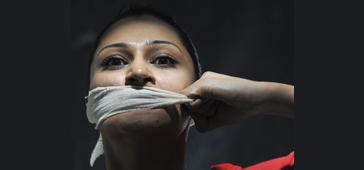 Many of you will recall the protests which emerged in 2004 when Gurpreet Kaur Bhatti went to stage her second play, Behzti. The play, which covered issues such as rape and violence within the setting of a gurdwara, caused an uproar in the Sikh community in Birmingham and was later canceled. Many community members welcomed the decision to cancel the play, while others argued that limiting the playwright’s free speech was actually detrimental to the Sikh community. It was nicely put in a Guardian article stating that, “The dispute became a classic conflict between the artist’s right to freedom of expression and a community’s wish to have their faith treated with dignity.”
Many of you will recall the protests which emerged in 2004 when Gurpreet Kaur Bhatti went to stage her second play, Behzti. The play, which covered issues such as rape and violence within the setting of a gurdwara, caused an uproar in the Sikh community in Birmingham and was later canceled. Many community members welcomed the decision to cancel the play, while others argued that limiting the playwright’s free speech was actually detrimental to the Sikh community. It was nicely put in a Guardian article stating that, “The dispute became a classic conflict between the artist’s right to freedom of expression and a community’s wish to have their faith treated with dignity.”
The Rep had taken the unusual step of inviting Sikh community leaders to a private preview to air their concerns, after which they agreed not to oppose the play if the setting was moved to a community centre. Bhatti refused. “I wanted to write a play about religious hypocrisy,” she explains, “for which the setting in a gurdwara was non-negotiable. The attempt to establish a dialogue with the Sikh community was well intentioned, but ultimately misinterpreted as an invitation to rewrite my play.” [link]
Gurpreet Kaur Bhatti later found a card among her Christmas mail that read: “Seasons Greetings. This will be your last Christmas. You are a disgrace to the race. Sending you lots of hate.” Bhatti was forced to go into hiding. Behzti sparked protests and death threats, and now the playwright is attempting to address the controversy in her new play, Behud – which translates colloquially as “beyond belief”.
The details are still very sketchy, but it seems that a dera associated with the highly controversial Maan Singh Pehowa was burned down in Sacramento this past weekend. Maan Singh has been accused of rape.
I write this post partially to clarify that it was not at a Gurdwara in Sacramento, as well as to give a place for discussion and thoughts. The police seem to have some indication that the fire was not an accident, although very few details are being provided. Could it be an arson against immigrants? Could it be an accident? Could it involve frictions within the Sikh community in Sacramento? I do not know. I would be interested to hear thoughts, especially from those readers in Sacramento.
A video from the local news about the fire can be viewed here.
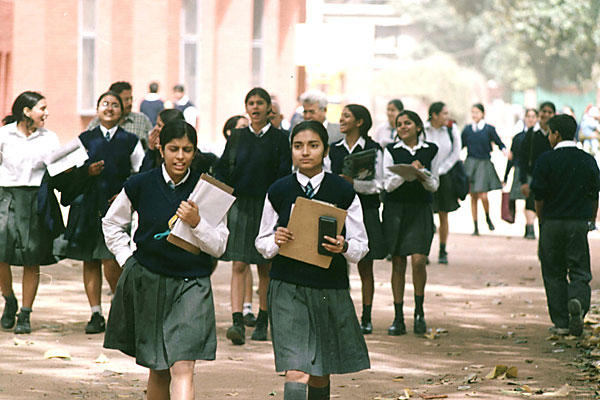 As communities around the world celebrated International Women’s Day yesterday, there were several interesting articles discussing the role of women in the world. Nicholas Kristof wrote about Three Proven Steps to Advance the World’s Women (education, micronutrients, and helping women start businesses). Another article talked about The World’s Best Countries for Women. The Christian Science Monitor discussed Gender Selection – an issue which we have often dialogued about here on TLH. The article talks about the repercussions of sex selective abortion – specifically, the gender imbalance leading to fewer women available to be wives.
As communities around the world celebrated International Women’s Day yesterday, there were several interesting articles discussing the role of women in the world. Nicholas Kristof wrote about Three Proven Steps to Advance the World’s Women (education, micronutrients, and helping women start businesses). Another article talked about The World’s Best Countries for Women. The Christian Science Monitor discussed Gender Selection – an issue which we have often dialogued about here on TLH. The article talks about the repercussions of sex selective abortion – specifically, the gender imbalance leading to fewer women available to be wives.
Villagers here say that the dearth of females has already had a direct effect on dowry customs: Dowries are getting smaller or disappearing altogether; instead, the onus is increasingly on young men to provide well for their future brides… Baljeet Singh, a 37-year-old truck driver, says he began to despair of finding a local wife once he turned 26. Men in this village, where most are farmers, consider it ideal to wed between 20 and 25. “I’m a van driver, I don’t have many prospects, and it seems that you have to have a very good job to get a bride these days,” he says. So last year, Mr Singh used his life savings to marry a 16-year-old Muslim girl from Assam; though village rumors have it that Sonu Khutum is an illegal immigrant from Bangladesh. She is happy to be living in a predominantly Hindu village, she says, joggling the couple’s 7-month-old baby girl on her hip. But lonely bachelors’ new quick fix, buying brides from impoverished parts of India, seems likely to do little to enhance the status of women. [link]
Guest blogged by Brooklynwala
This week the South Asian Magazine for Action and Reflection (SAMAR) along with Theaters Against War (THAW), published several letters of support they solicited for Syed Fahad Hashmi, a US citizen who has been held in solitary confinement since May 2007 in the Metropolitan Correctional Center in New York City. That’s right, solitary confinement, debatably a form of torture, for almost 3 years – not at Guantanamo Bay, but in downtown Manhattan. Fahad is awaiting trial and has not been convicted of any crime.
Journalist Chris Hedges wrote, “The case against Hashmi, like most of the terrorist cases launched by the Bush administration, is appallingly weak and built on flimsy circumstantial evidence… If it were a matter of evidence, activists like Hashmi, who is accused of facilitating the delivery of socks to al-Qaida, would probably never be brought to trial.”
I wrote a letter to Fahad last week, which you can read in its entirety below. Check out all the letters published in SAMAR here. To me, there is a deep connection between Fahad’s unjust incarceration and the discrimination and racism we as Sikhs face throughout the world. I hope that more of us get involved in the movement to free Fahad Hashmi and stop the draconian policies of the U.S. government, which continue under President Obama’s leadership.
International Women’s Day is celebrated on March 8th each year and is a major day of global celebration for the economic, political and social achievements of women. We have previously posted about well known examples of women in our history who have made huge contributions to Sikhi. Perhaps on this day we can take the time to continue recognizing the numerous Sikh women who stood alongside Sikh men to help our qaum. I recently read about twenty Sikh women in a document titled, “Noble and Brave Sikh Women” by Sawan Singh. The author writes,
Bibi Rajinder Kaur and Bibi Sahib Kaur both belonged to the royal family of Patiala state. Their bravery in the battlefields and their skills in administration saved the state from being ruined. Mata Kishan Kaur and Bibi Balbir Kaur took part and suffered in the Akali movement for the control of Gurdwaras. Bibi Balbir Kaur even sacrificed her own life and that of her innocent child in this movement. Bibi Harnam Kaur has done wonders to spread female education among the Sikh women a hundred years ago. Mai Bhag Kaur has proved that Sikh women can lead and organize the Sikh men and win battles. Women martyrs of Shahid Gunj of Lahore like Bhghel Kaur cannot be found in the literature of many religions. Bibi Sharan Kaur and Bibi Shamsher Kaur have proved their skills in the battlefield and in administration. Bibi Anoop Kaur, Bibi Shushil Kaur, Bibi Harsharan Kaur, Bibi Basan Lata and Bibi Nirbhay Kaur have faced odds and sacrificed their lives to save their honor and faith.
The document is a great starting point to begin learning about the immense history of Sikh women that often goes untold. Are there any events in your community being planned for International Women’s Day? How do we, in general, recognize the contributions of women in Sikh history?
On TLH we have addressed various issues effecting the South Asian elderly community. The recent news article in the the New York Times on the difficulties encountered by many Sikh seniors in the California Bay Area was particularly heart wrenching.
In an article in New America Media, Paul Kleyman discusses the impact of depression on ethnic seniors. Many of his statements of seniors feeling alone and depressed resonated with the stories I have heard about Sikh seniors. I have often heard how Sikh seniors feel like America is a “sweet prison”. You have many material benefits, but also a tremendous amount of social isolation. Even when living with their children and grandchildren, the elderly miss their social life back in Punjab. In the US, the elderly spend the majority of their day separated from their children and grandchildren in time and space. Also, generational gaps coupled with cultural differences create social and emotional distance.
Kleyman writes that ethnic seniors are expected to have similar levels of depression as the white elderly population (about one in six people ages 50 and above), but the main difference is:
“… that African-American, Latino, Asian and Native-American seniors are less apt to get treated. That’s because of their higher levels of poverty, lack of insurance or access to treatment and the pervasive stigma of mental illness in many cultures. Left untreated, depression, anxiety disorder and related conditions can result in debilitating physical ailments, as people eat and sleep more poorly and become less physically active. ”
An interesting infographic circulating the Web has many people talking about the relationship between wealth and religion. The graphic, titled The Almighty Dollar, was created by GOOD and Column Five Media and breaks down income levels in the U.S. by religion. Data is based on information from the Pew Forum and it compares the income level of each religion to the national average. From the website: It’s no secret that the distribution of wealth is inequitable in the United States across racial, regional, and socio-economic groups. But there is a distinct variance among and within America’s faiths as well.
If you click on the image above, it will enlarge and you’ll see information broken down by several religious groups such as Jewish, Christian (divided into several groups), Buddhist, Mormon, Muslim etc. You’ll notice that Sikhism is not one of them (not sure why?). There are five income brackets (Less than $30,000 to $100,000+) listed and numbers signifying what percentage of each religious group falling into which income bracket.
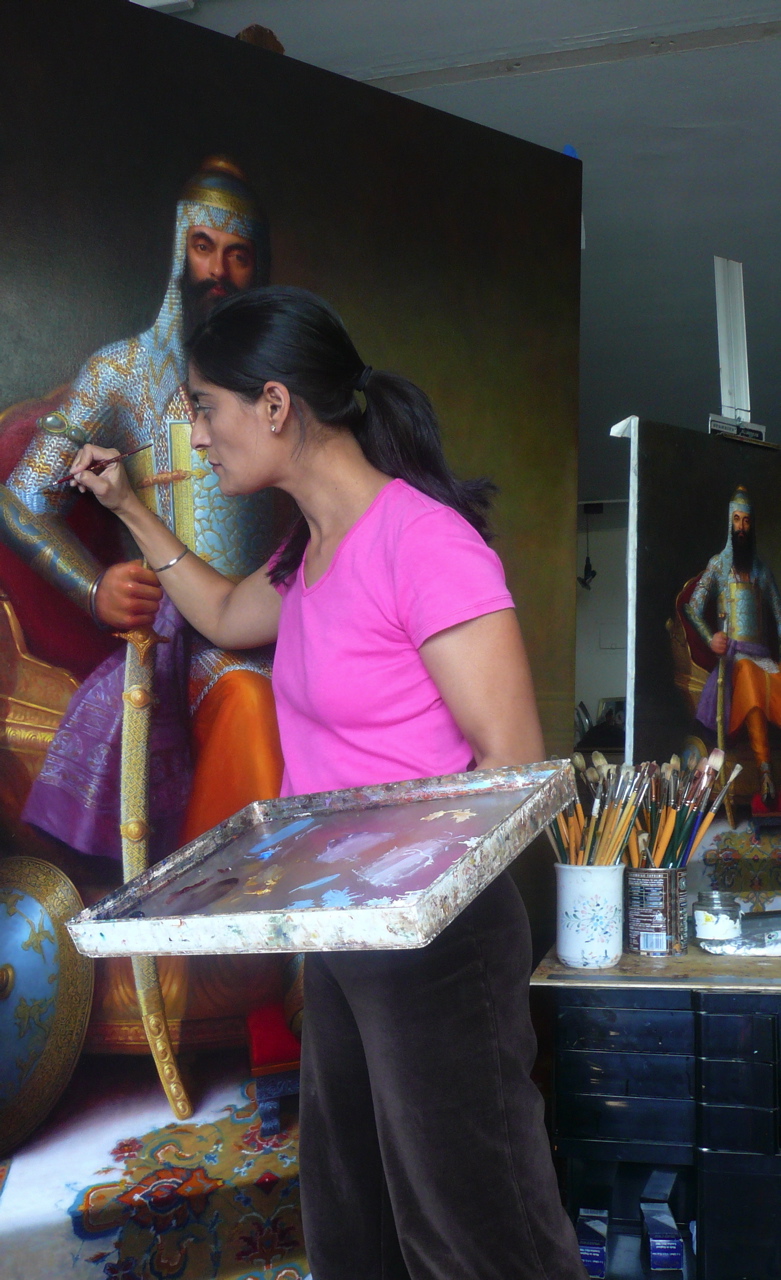 If you’re in the Toronto area this weekend, a wonderful event awaits you! The Royal Ontario Museum will be celebrating South Asian Heritage Day which will bring together artists, authors, performers and filmmakers to showcase South Asian culture. The event will showcase Manu Kaur Saluja’s Kings of the Punjab portraits at the Sir Christopher Ondaatje South Asian Gallery. Children will have the opportunity to enjoy a special reading by author Navjot Kaur of her children’s book “A Lion’s Mane” which explores Sikh identity and the many connections we share as global citizens. Event details can be found here.
If you’re in the Toronto area this weekend, a wonderful event awaits you! The Royal Ontario Museum will be celebrating South Asian Heritage Day which will bring together artists, authors, performers and filmmakers to showcase South Asian culture. The event will showcase Manu Kaur Saluja’s Kings of the Punjab portraits at the Sir Christopher Ondaatje South Asian Gallery. Children will have the opportunity to enjoy a special reading by author Navjot Kaur of her children’s book “A Lion’s Mane” which explores Sikh identity and the many connections we share as global citizens. Event details can be found here.
South Asian Heritage Day 2010
Royal Ontario Museum
Sunday, February 21, 2010
11am – 4pm
“Grand harmony aims at elevating every unit of social and cultural life to the height of heroic majesty”
– Harinder Singh Mehboob (1937-2010)
Revered Punjabi poet, Harinder Singh Mehboob, passed away on Sunday night leaving behind a significant mark on the map of Punjabi literature. Mehboob, who had also worked as Principal of Khalsa College Gardhiwala, had written Sahji Rachio Khalsa and Jhanan Di Raat, a book on poetry which he received an award for in 1991. The Sahiyta Award was not without controversy. Regardless, Mehboob’s work will continue to be appreciated by the community:
Jhanan Di Raat which wins Sahitya Akademi Award for Punjabi is his second major publication. A collection of over two hundred poems, written over a period of three decades, in seven anthologies of poetry now published as one volume, Jhanan Di Raat is a formidable work both in conception and in content. The stylistic range and virtuosity reflected by this 828 page volume is enormous; and while the ideological orientation and the concerns of the age as reflected in the poems change gradually, the poet’s warm humanism is always extent.
The poet’s synthesis of the folk poetic traditions with contemporary trends is a distinctive feature; and a recurrent theme is his deep nostalgia for the past glory of Punjab. For its variety of styles, images and metaphors, its vastness of scope, its amalgamation of modern diction with folk-forms and its poetic intensity, this work is regarded as an outstanding contribution to Indian poetry in Punjabi. [link]
He will be remembered and appreciated for elevating Punjabi literature and for his important contributions to the Qaum.
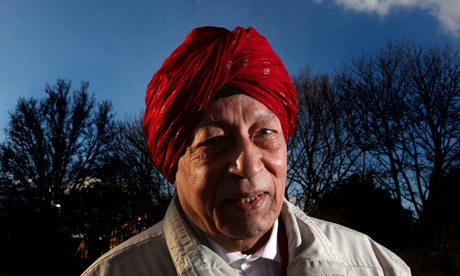 In some way I know I shouldn’t even be writing this. I am giving an idiot the fame that he seeks, but doesn’t deserve. Oh well, here we go.
In some way I know I shouldn’t even be writing this. I am giving an idiot the fame that he seeks, but doesn’t deserve. Oh well, here we go.
So Rajinder Singh is an idiot. Rajinder Singh wants to be the first non-white to join the British National Party (BNP) in the UK. To those from elsewhere, the BNP is similar to the KKK, without the sheets and ropes. For years they had limited (if that’s the right word) their membership to people of “Caucasian origin.” The Equality and Human Rights Commission had threatened them with a court injunction if they did not open up their ranks.
Playing on the issue of anti-immigration and Muslimophobia, the fast blinkers (read conservatives) are making some noise in the wake of the economic downturn. However, due to a court ruling and a willing lackey, it seems the BNP is about to gain Rajinder.
For the cameras, Rajinder has decided to label himself a Sikh and wear a turban.
Singh – admits he’s only wearing it for my ¬ benefit. He’s not a religious man and is clean shaven, but he wore a turban the first time he ever had “media exposure” – on BNPTV, the party’s online ¬channel – and has decided to do so whenever speaking to the media because “the message carries more weight” coming from a turban-wearing Sikh.[link]
My question – does wearing a turban give him more ‘weight’ amongst Sikhs or non-Sikhs?

